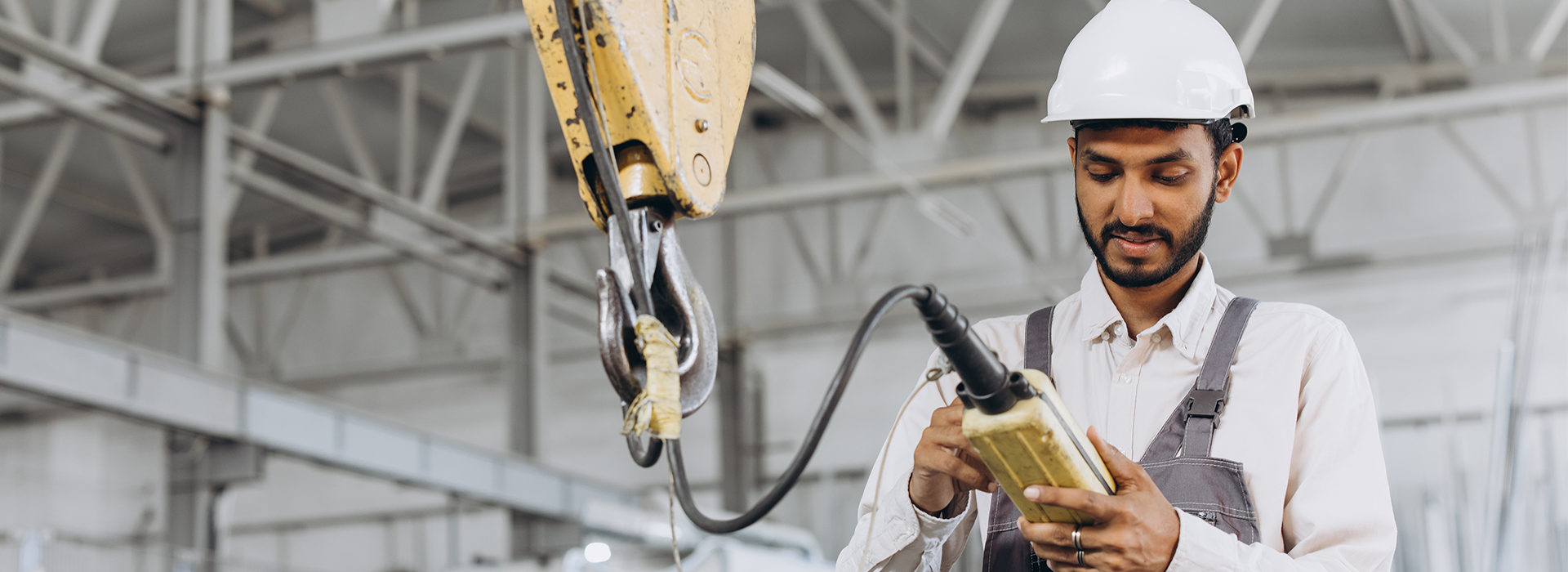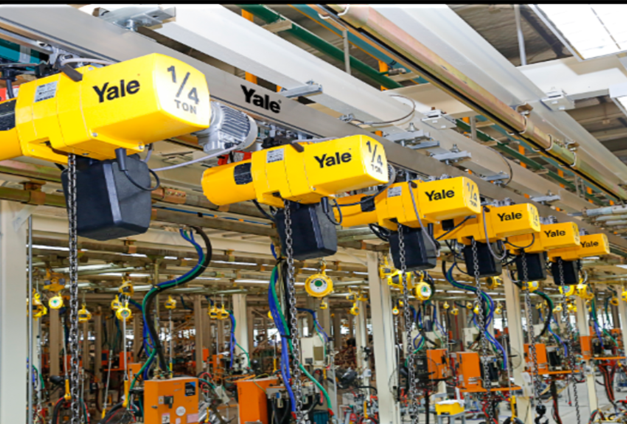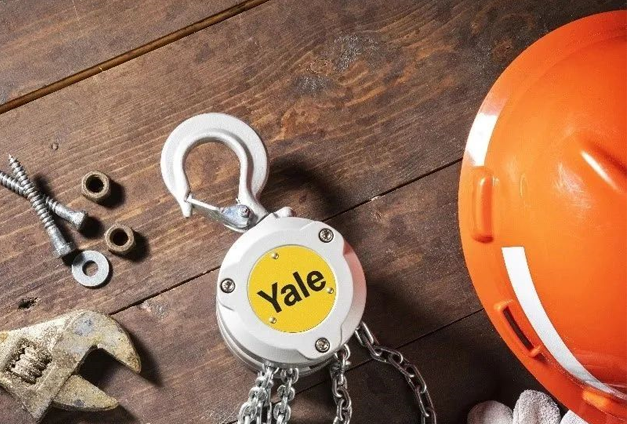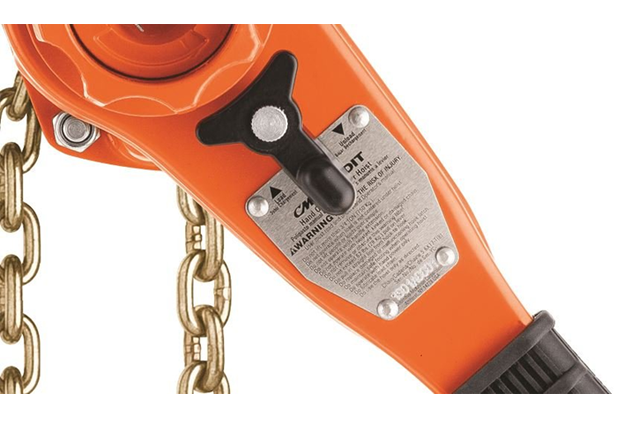Four special cranes from STAHL CraneSystems are used at a German car manufacturer's plant.
No two cranes are alike. But if you are looking for a very special solution, you need to turn to engineering experts in this field, such as our crane partner Haslinger GmbH, which installed no fewer than four wall-mounted cranes at a leading German car manufacturer's plant in southern Germany. Besides the fact that such cranes are quite rare in themselves, the cranes have several special features.
"We are a traditional steel construction company. In addition to designing and producing cranes, we also manufacture stage sets, platforms and staircase structures. Our range of services also includes manufacturing with a focus on coating and laser flame cutting," says Robert Seibold, Head of Crane Technology at Haslinger. The company, based in Aldersbach-Uttighofen, not far from Passau, has been working with STAHL CraneSystems for more than 12 years.
In addition, Haslinger also undertook the steel construction part of the entire project. Thanks to the high level of in-house optimized production at STAHL CraneSystems, the company exclusively uses standard crane components from STAHL CraneSystems to build customized crane systems. "And, as you can see from a project for a leading German automobile manufacturer, these are sometimes very special solutions," says Robert Seibold.
Double-girder wall-mounted crane replaces existing system
The technical features stated during the tender process and the corresponding concept for the project implementation plan ultimately convinced the customer and enabled Haslinger to win the project in mid-2020. Specifically, the project involves the design, production, delivery and installation of a total of four double-girder wall-mounted cranes. In a first step, two systems were initially planned for a plant building for the inspection and preparation of equipment for the production of car body parts.
The plant building already had old wall-mounted cranes with a lifting capacity of five tons each, but they were no longer able to meet future logistics requirements and were therefore replaced by new cranes, which now have a lifting capacity of eight tons each.
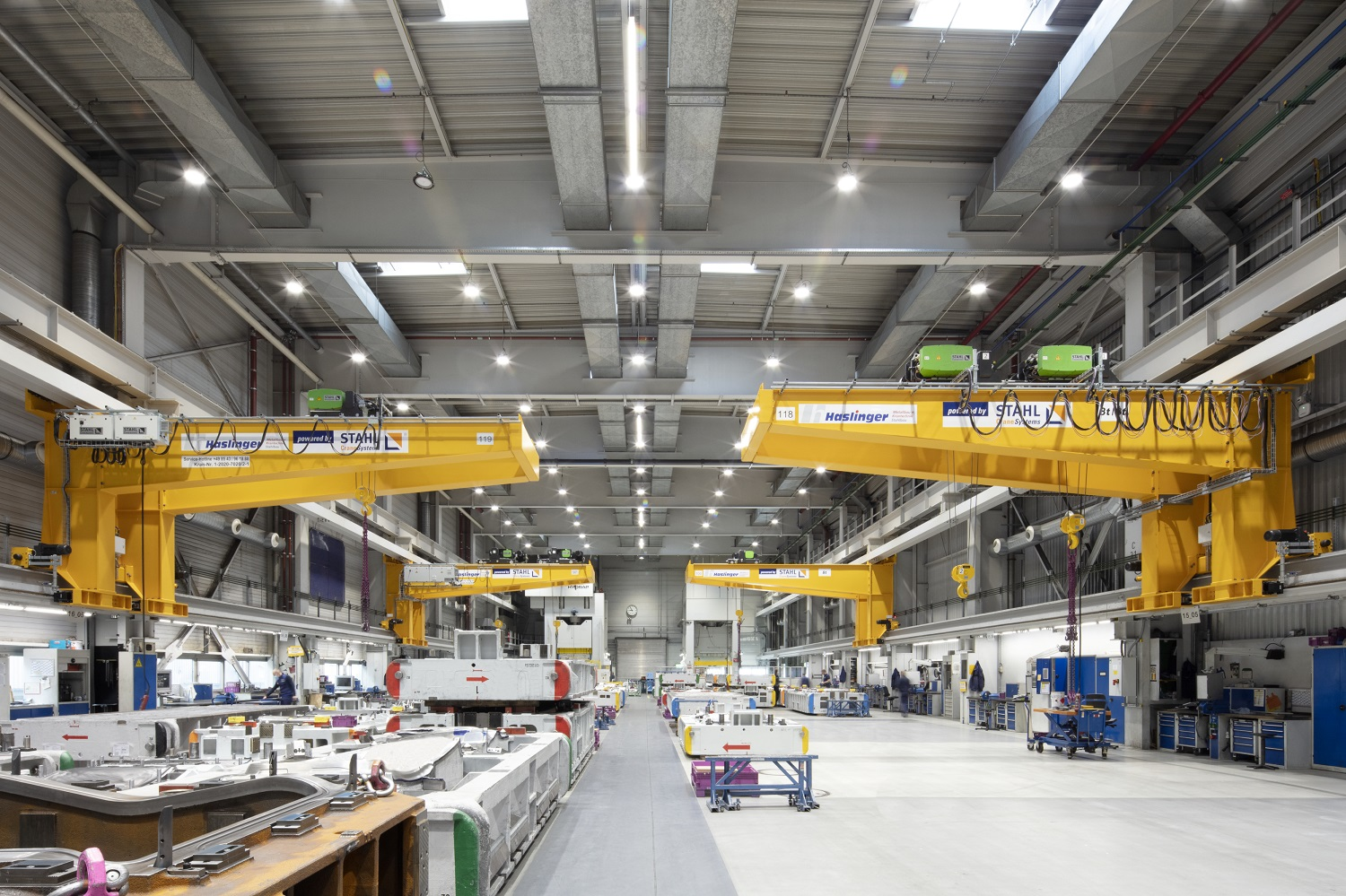

Image from STAHL CraneSystems GmbH
During the various construction phases, two wall-mounted cranes were installed on each side of the plant building: one crane was equipped with an SH 5025-20 electric wire rope hoist with a S.W.L. lowered to 8 t (front), the other crane was equipped with two SH 6040-10 electric wire rope hoists from STAHL CraneSystems (rear). The standard wire rope hoists can be individually modified according to customer requirements and equipped with additional safety technology, such as the STAHL multifunction controller SMC 22.
Flexibility and performance for a larger area
Looking back, Robert Seibold sees the construction of the wall-mounted cranes as a real challenge for the project: "Compared to bridge cranes or suspension cranes, there is rarely a need for such cranes. Moreover, these are very individual solutions according to the customer's specifications, for which we have to take the entire range of requirements into account. In addition, the cranes have to be installed without disrupting the work in the plant. However, we already knew this from other projects and were able to adapt it in our planning and implementation."
Four wall-mounted mobile cranes supplement the existing bridge cranes, thus creating further room for maneuvers for multi-level work processes. With a cantilever length of 8.4 metres per crane and a crane track length of 80 metres, the new cranes can reach almost every point in the approximately 1,600 square metres of plant. The wall-mounted cranes are thus able to serve all work areas simultaneously, without having to use a main crane, which might not be immediately available because it is needed in another part of the plant.

Two cranes, one with two wire rope hoist trolleys and the other with one wire rope hoist trolley, are arranged diagonally and complement the bridge crane to create further movement space for multi-level work processes. With a jib length of 8.4 meters each and a crane track length of 80 meters, the new solution can reach almost every point in the approximately 1,600 square meter factory building.
More precise lifting heights
The project was basically divided into two construction phases, with two wall-mounted cranes installed on one side of the factory building in each phase. "We had reinforced the crane rails appropriately beforehand so that they could take the weight of the new cranes. In order not to interfere with the ongoing work in the plant building, the first two cranes were installed alternately in 2020/2021," mentions Robert Siebold.
Haslinger chose the SH 5025-20 electric wire rope hoist for one of the two double-girder wall-mounted cranes with a lifting capacity of 8 t and a lifting height of 6 m. The SH series wire rope hoists are available in five sizes and 27 lifting capacities ranging from 500 kg to 32,000 kg. The compact and low-maintenance hoists can be used in stationary applications as well as in trolleys in standard and non-standard cranes (in today's case, a trolley with a maximum operating speed of 10 m/min was used).
In this regard, although all the cranes used in this project were standard wire rope hoists, they were custom-made according to the customer's requirements and equipped with additional safety technology, among other features. Robert Seibold gives an example: "The wire rope hoist we selected has a maximum lifting speed of 10 m/min. However, the customer wanted the speed to be halved, which we solved with an intermediate gear. The lifting speed of 5 m/min now allows for greater precision when lifting and lowering loads."
Continuous recording of important operating data
An important component of the SH 5025-20 wire rope hoist in this project is the STAHL SMC 22 controller for continuous load measurement and automatic load control, which stops immediately in the event of an overload. As a load spectrum memory, the SMC also records extensive operating data in real time, including operating hours, operating hours at full load, number of motor switching operations and other parameters that are important for the stable performance and safe operation of the hoist. Using the ConfigTool software provided by STAHL CraneSystems, the operator can quickly and easily read out and evaluate the operating data on a PC or laptop.
"Using the SMC, the service life of the hoist can also be calculated very accurately. In addition, if the hoist fails, the recorded data can trace the cause of the accident," says Robert Seibold, who describes some of the advantages of this crane system.
Independent operation or linkage to increase lifting capacity
The second wall-mounted crane is identical in design to the first, but has some special features that have been further improved, for which the crane statics had to be designed. Two hoist trolleys run on the upper flange of the main beam of this crane, more precisely two SH 6040-10 wire rope hoists from STAHL CraneSystems with double rope grooves and 4/2 roping, which prevent lateral movement of the hook when raising and lowering the load.
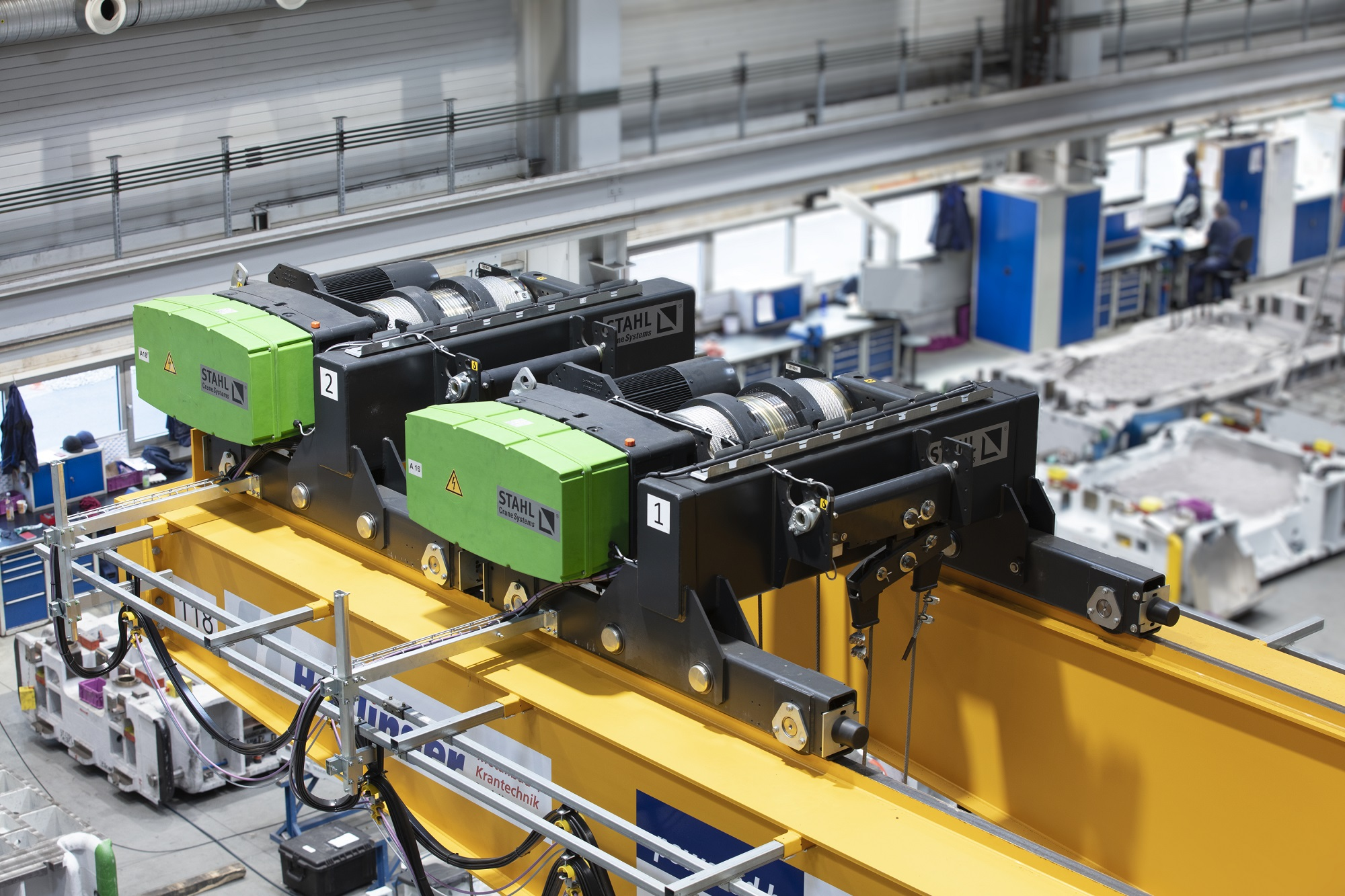
SH 6040-10 Wire Rope Electric Hoist has a double rope groove drum and 4/2 rope winding method,
which prevents the hook from moving horizontally when lifting and lowering the load.
In joint operations,
longer workpieces can be transported more easily and positioned more accurately. At the same time, the load remains in a stable position on both hooks.
These hoists are also designed with a load capacity of 8 tons per unit and a lifting height of 6 meters, allowing single or double operation, so they are highly flexible in use. The load superimposed device with safety PLC is suitable for linkage operation. It permanently measures and monitors the loads on the two hooks, thus ensuring that the total permissible load capacity of the crane does not exceed 8 tons. “In linked operations, longer workpieces can be transported more easily and positioned more precisely. At the same time, the load remains in a stable position on both hooks, which also prevents the load from swinging. In single crane operation, the tool can be turned and rotated safely,” explains Robert Seibold and emphasizes: “In my opinion, load synthesis with safety PLC is the unique selling point of the STAHL CraneSystems wire rope hoist, because the solution has a very high safety level. The control system is designed according to EN 15011 and meets the requirements with a high-performance PLC or PLD.”


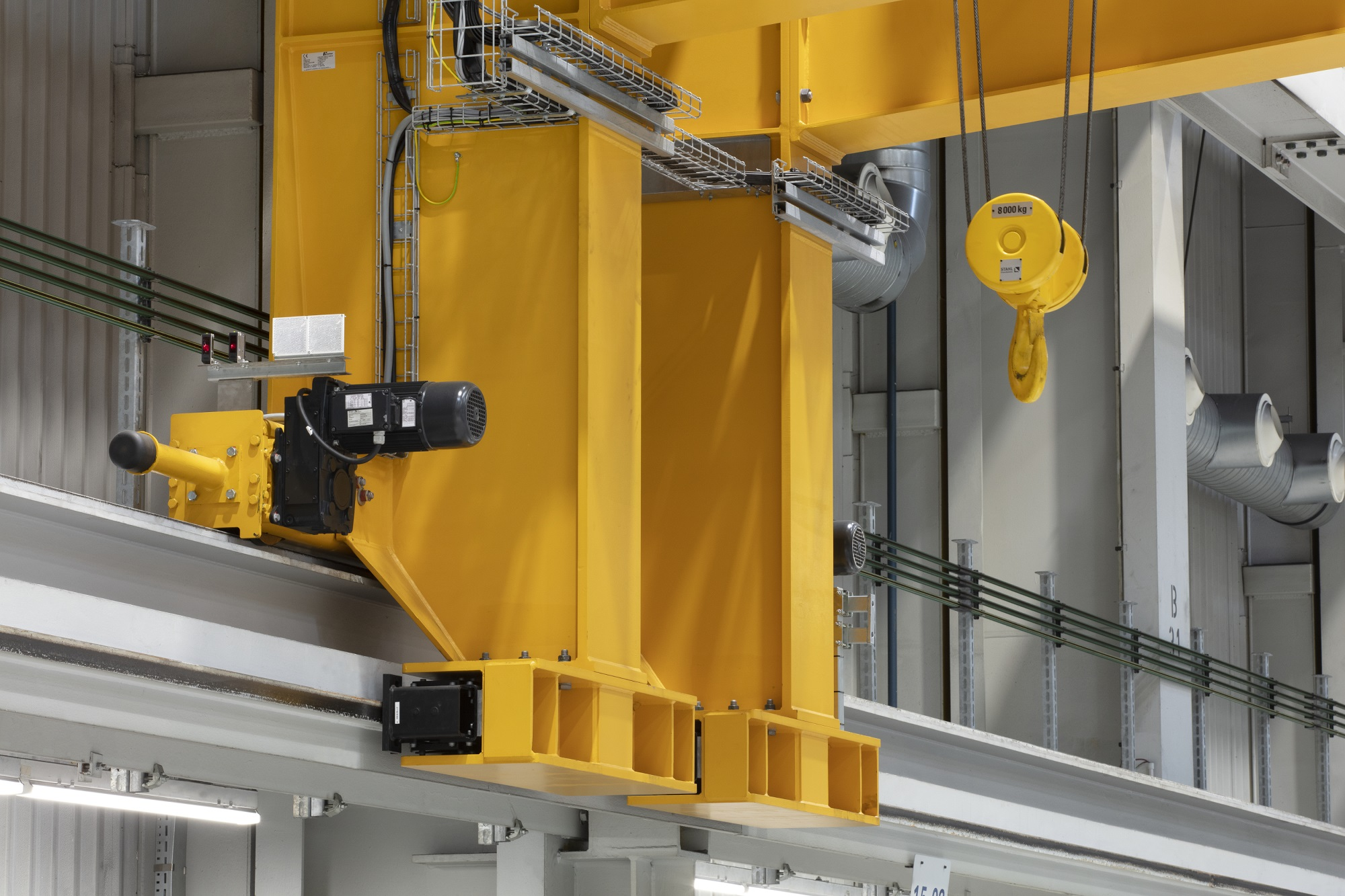
Haslinger also uses STAHL CraneSystems' standard end beams and wheelsets enable a special design of crane end beams and travel gear, which are supported by three crane tracks on both sides of the plant. Each crane has two frequency-controlled trolley travel gears mounted on the lower end beam, running on the middle crane track. Each end beam is a 4-wheel design, with very high wheel pressure evenly distributed on the lower crane tracks.


